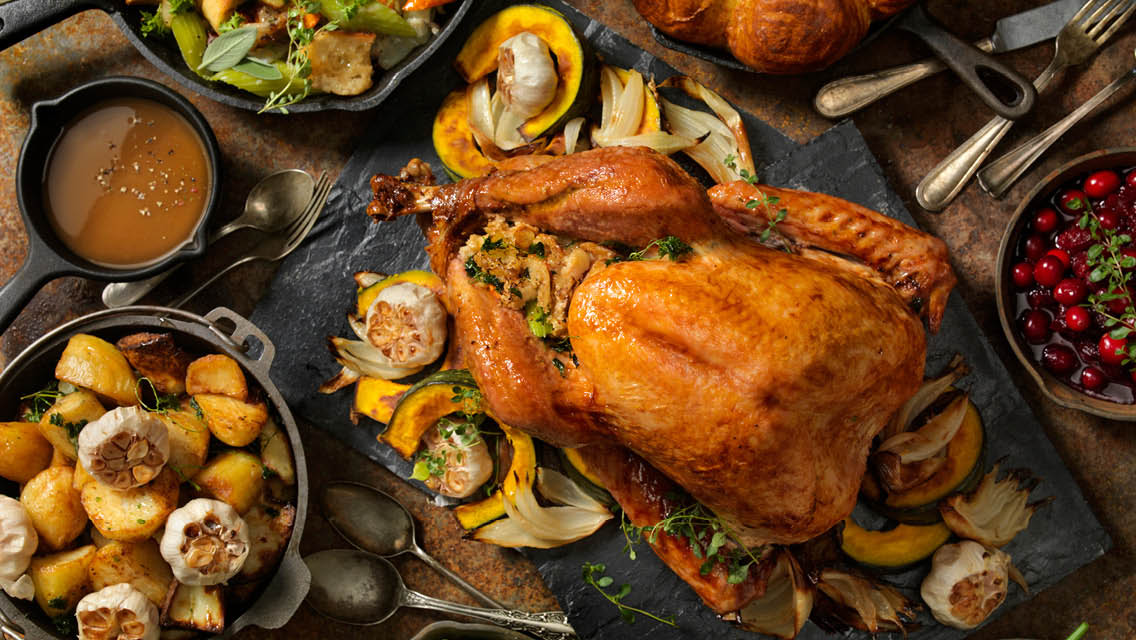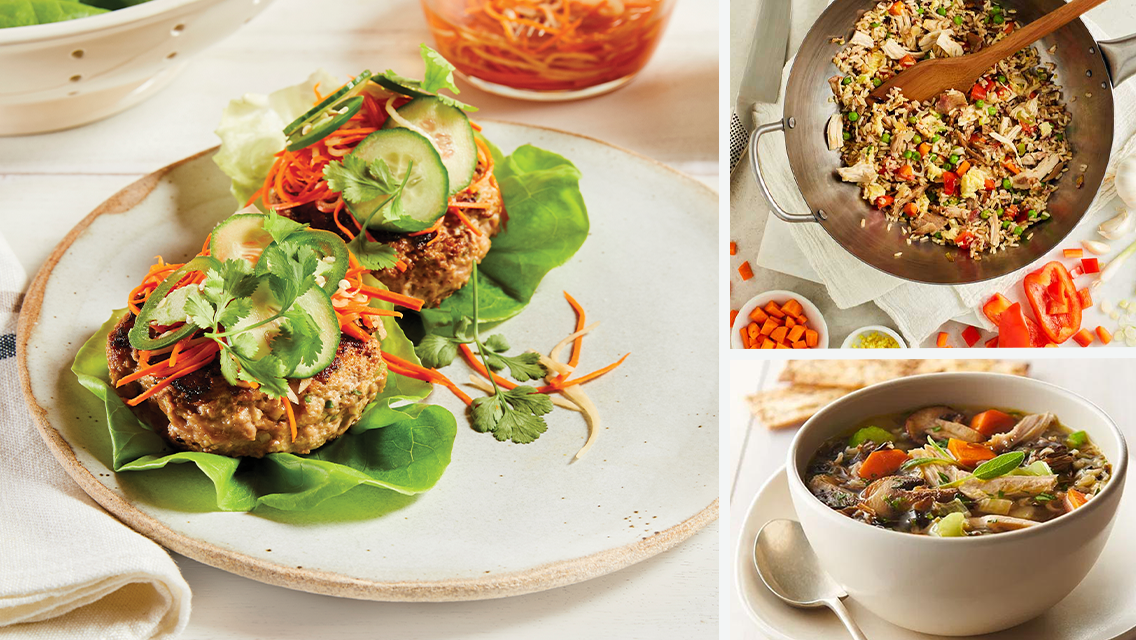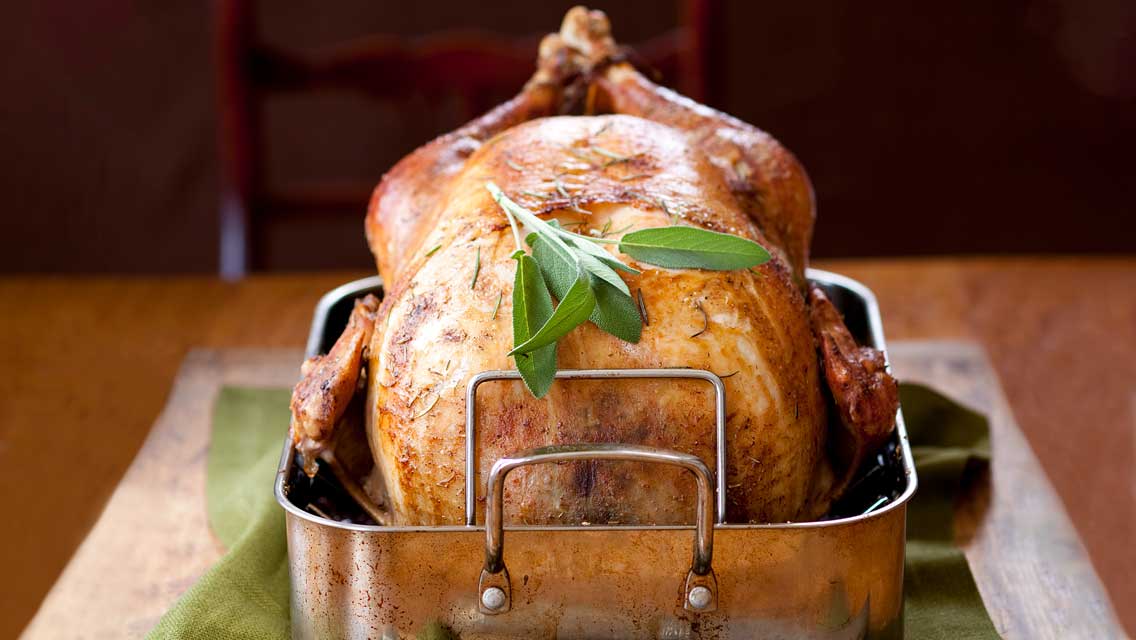The traditional Thanksgiving dinner centers on a giant, steaming stuffed turkey. No need to mess with that. But have you ever thought about what kind of bird you’re actually serving? Ever wondered where it came from, or how it was raised?
Over the last few years my family has fallen in love with heritage turkeys. A heritage turkey is a special kind of bird – one more akin to those our great-grandparents enjoyed. It bears relatively little resemblance to the commodity turkeys found on most conventional-supermarket shelves.
Heritage turkeys are generally raised by specialty farmers who offer them decent living conditions and a more natural environment, one free of antibiotics, feed additives and chemicals. This is a stark contrast to the majority of poultry raised today, much of which comes from factory farms that use water-holding chemicals and antibiotics to raise “superbirds” in a short amount of time.
Commodity birds are bred for their broad breasts and abundance of white meat, but they often need additional moisture added to their meat because their lack of mobility creates poor muscle development. Also, most factory-farm turkeys are sold frozen, and freezing any meat with high moisture expands and breaks the protein strands, which can make the texture feel and taste rubbery.
Heritage birds are longer and leaner than conventional turkeys, with meatier legs and narrower breast muscles. Most heritage turkeys are processed at 24 to 26 weeks old (most supermarket turkeys are harvested between 12 and 16 weeks) and weigh between 10 and 15 pounds. This extra time really makes a difference. At 5 months old, turkeys add a distinctive layer of fat necessary for prime flavor and tender eating. This fat layer is also loaded with more healthy omega-3 acids than commodity birds harvested much earlier.
Heritage turkeys are far from “new,” and farmers like Joanne Griffin of Hawk’s Valley Farm in Spring Grove, Minn., and a growing number of others across the country, are helping to make heritage birds much more accessible. After learning about heritage birds from an old newspaper article, Griffin was inspired to do some online research and find out all she could about them. She contacted the American Livestock Breeds Conservancy, ordered a slew of different chicks from several species and now breeds her own each year. Griffin raises them the old-fashioned way – plenty of sunshine, wild feed and room to roam.
The most common heritage turkeys are the same ones sold 60 years ago: Narragansett, Bourbon Red, Royal Palm, Blue Slate and Black Spanish. They typically are more expensive than supermarket birds – about $2 per pound more – but prices continue to fall each year as consumer demand increases. And you get quite a lot for your money. Not only is the flavor superb, but a 10- to 12-pound heritage bird can feed four to six people with plenty of leftovers for sandwiches and soups.
So why not buck tradition this year by starting a new tradition of your own? Make a heritage turkey the centerpiece of your Thanksgiving meal. You’ll be thankful you did.
Turkey Tips
Heritage turkeys require some extra care when cooking, but they are well worth the effort.
- Wash your turkey in cold running water and pat dry with paper towels. Then brine it overnight in an herb-sugar-salt solution to season from the inside out (see recipe, opposite page). Let sit on a roasting rack to drip dry in the fridge, uncovered, for approximately 12 hours before cooking. This promotes a crisp skin and allows the muscles to relax after brining.
- Rub the entire turkey with a smidge of butter to encourage even browning.
- If you are preparing a large heritage turkey (more than 14 pounds), poach the backbone (dark meat side) of the bird in a shallow pan filled with 1 inch of boiling stock for 10 minutes before stuffing and roasting. This gives the dark meat, which takes the longest to cook, a head start.
- Stuff your heritage turkey however you desire and cook at 325 degrees until the internal temperature of the thigh meat is 160 degrees. This guarantees that the connective tissues unique to poultry’s dark meat have broken down and are tender. Because heritage turkeys are smaller than supermarket birds, roast them breast down to keep the breast meat moist.
- No basting! This dries out the turkey by putting oven-temperature melted fats (200 degrees hotter than your average turkey’s internal temperature during cooking) on the parts you are trying not to overcook.
Perfect Thanksgiving Turkey, Gravy and Stuffing
The Turkey
- 1 fresh heritage turkey, 12 to 14 pounds (consider a Bourbon Red)
- 1/2 cup salt
- 1/2 cup sugar
- 1/2 stick softened sweet butter
- 2 tbs. paprika
The Gravy
- 1 large Spanish (yellow) onion, diced
- 3 cups rich turkey or chicken stock
- 3 tbs. flour
- 3 tbs. sweet butter
The Stuffing
- 8 cups cubed, dried, seasoned bread cubes
- 2 tbs. fresh minced sage leaves
- 1 pound fresh chestnuts, in the shell
- Turkey liver and gizzard from the bird, minced fine
- 3 ounces fresh chicken livers, minced
- 1 cup minced celery
- 1 cup minced Spanish (yellow) onion
- 2 tbs. melted butter
- 2 tbs. minced parsley
- 1 tbs. fresh thyme leaves
The Process
2 Days Before
- Brine your bird: Place the turkey in a large pot; add enough cold water to cover it.
- Remove the bird and reserve to a platter for a moment.
- Dissolve the sugar and salt into the water by gently stirring.
- Return bird to the large pot.
- Refrigerate for 12 to 16 hours.
1 Day Before
- Remove bird from the brine and place on a roasting rack fitted into a roasting pan to catch any drips.
- Allow bird to dry, uncovered, for 24 hours in the refrigerator. This will tighten the skin for extra crispness and color.
Serving Day
- Remove the turkey from the refrigerator and let rest for one hour at room temperature.
- While the bird sits, place an X mark with a paring knife across the tops of the chestnuts and roast at 350 degrees for 25 to 30 minutes until cooked through.
- Peel and reserve nutmeats, slicing them into quarters as best you can.
- Place the sliced onion into the bottom of the roasting pan along with the turkey neck, so the drippings will land on the onions. Set aside.
- Combine the bread cubes, chestnuts and the other stuffing ingredients in a large mixing bowl.
- Season with salt and pepper.
- Stuff the turkey and place any remaining stuffing in a suitable oven-to-table casserole dish and reserve.
- Rub turkey with the soft butter and sprinkle lightly with the paprika.
- Tie or skewer legs together. Place the racked turkey in a 325-degree oven, breast side down, and roast for about 16 minutes per pound.
- Check that the thigh meat has reached a temperature of 160 degrees. To do this, insert a food thermometer into the meatiest part of the thigh and take the temperature. NOTE: Do not touch the bone with the thermometer. Repeat this process with the deepest part of the stuffed breast. For safety, it should be over 145 degrees.
- When the turkey is done, let it rest in a warm part of your kitchen. Place the baking dish with the spare stuffing into the oven and turn up the temperature to 375 degrees. Cover the stuffing loosely with aluminum foil. Bake for 35 to 40 minutes while you carve the turkey and make the gravy.
Finishing
- Place the turkey on a carving board and tent with aluminum foil. Set aside.
- Pour stock into the roasting pan, place pan over medium heat and bring to a boil, scraping back and forth to loosen any “roasty-toasty” bits that may stick to the pan. Lower to a simmer until the liquid reduces to roughly 2 1/2 cups.
- Pour the contents of the roasting pan through a mesh strainer and into a large work bowl. (Discard the contents of the strainer.) Skim off all the fat and reserve.
- Combine the flour and butter in a 1-quart saucepan. Cook for several minutes over medium heat to make a cooked roux.
- Add the strained and reserved stock to the roux, in thirds, whisking as you go. Gently simmer until thickened to gravy consistency and season with the salt and pepper.
- Carve your turkey and place on a platter. Pour any juices you accumulate during carving into the gravy pan. Then serve.
Looking for more Thanksgiving recipe ideas? Visit “Your Thanksgiving Menu Planner“.





This Post Has 0 Comments